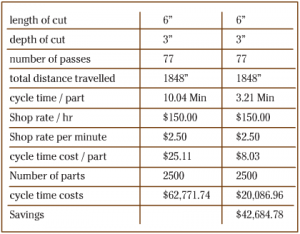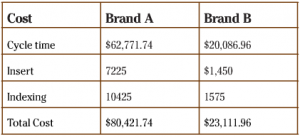There’s a trend in the industry for cutting tool manufacturers to offer free milling cutter bodies. On the surface this looks like a great proposal. However, this can be a costly proposition if you don’t do your homework. There are many factors to consider. One must consider the price of the insert, the life of the insert, the cycle time costs and the cost to index inserts, just to name a few.
A real life example of this is with a high feed cutter. The end user was considering two brands. Both cutters were 1-inch in diameter Brand A had two inserts while Brand B had five. Both cutters ran at 600 SFM or 2,300RPM. Brand A ran with a 0.040-inch chip per tooth, while Brand B ran at 0.050-inch chip per tooth. Therefore, Brand A ran at 184 inches per minute while Brand B ran at 575 inches per minute.

Cycle Time
To consider the financial impact we need to look at this as cycle time per part. In this instance the part had four six-inch long slots, three inches deep. The cycle time worked out to just over 10 minutes for Brand A and 3.2 minutes for Brand B. At a shop rate of $150 per hour that meant Brand A’s cycle time cost was $25.11 per part, while Brand B’s cycle time cost per part was only $8.03. Considering the lot was 2,500 pieces Brand A had cycle time costs of $62,771.74, while Brand B’s was $20,086.96. Brand B would have saved the user $42,684.

Insert cost is another factor. Brand A ran for 30 minutes with only 2 inserts. Brand B had 5 inserts but ran for 90 minutes. Both inserts had a cost of $13.00. Brand A had three edges, while Brand B had four edges per insert. The cost per cutter load for Brand A was $13/3 edges x 2 inserts or $8.67. Brand B cost per cutter load was $13/4 edges x 5 inserts or $16.25. However, Brand A had a tool life of three parts. Brand B was capable of producing 28 parts. This means insert cost per part for Brand A was $8.67/3 parts, or $2.89 per part and Brand B was (16.25/28) $0.58 per part. Over a run of 2,500 parts Brand A had an insert cost of (2,500parts x $2.89) $7,225 and Brand B had an insert cost of (2,500parts x $0.58) $1,450. Brand B had an insert savings of $5,775.
Another factor to consider would be the time required to index an insert. This cost could be avoided by running redundant cutters. That is to have a fully loaded milling cutter in the magazine ready to deploy when it is time to index the inserts. The time required to index inserts was five minutes for Brand A and seven minutes for Brand B. Brand A indexed after every third part. Brand B indexed after every ten parts. Therefore indexing cost for Brand A was (2,500/3 parts) 834 indexes x 5 minutes per index or 4,170 minutes. At $2.50 per minute shop rate that is a cost of $10,425. Brand B required 90 indexes at 7 minutes each or 630 minutes of indexing time or $1,575. Brand B had a indexing time savings of $8,850.
The total cost for both brands was as follows:

Brand B showed cost savings of Over $57,000
To be fair, Brand A offered their cutter for free while Brand B had a cost of $350 for its cutter body.
As you can see, even if Brand A offered free cutters and free inserts, it would still be more cost effective to use Brand B.
Some readers may be skeptical of the $150 per hour shop rate. Yet at a shop rate of $75 per hour the savings would have been $35,968.75 or with a shop rate of only $35 per hour the savings would have been $24,585.42.
Without having done the homework and considered all of the costs the Brand A sales person was able to convince the user that a free cutter and a cost to load the cutter of only $8.67 as compared to $16.25 was the way to go for the tool. The free cutter saved the end user $350 but cost him $57,309.08 a costly mistake.
That’s not to say all free cutters are bad. But to make the best decision, one must do their homework and consider all the factors before they cut. CM
John Mitchell is general manager at Tungaloy Canada.
www.tungaloyamerica.com

